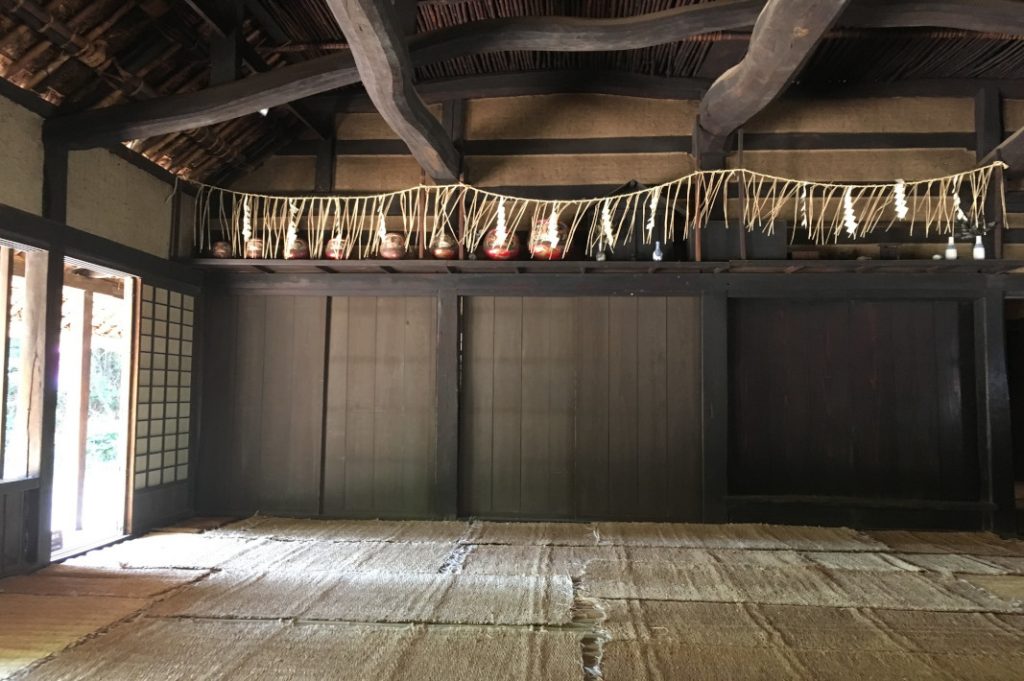In its sunken hearth, the fire crackles enticingly. Its guardian, an elderly woman with a face formidably composed of smile lines, waves us closer. We settle onto the tatami and sink into a companionable silence. The moment feels festive, ancient, sweet. It’s as if we’ve been allowed to step back into Japanese folk history, as if we’ve even been welcomed into someone’s home. Painstakingly transplanted from all of Japan’s corners, our cozy little corner is only 1 of over 25 stunning examples of rural, folk architecture preserved at Nihon Minka-en, Tokyo’s Open-Air Folk House Museum.

Open-Air Folk House … Museum?
I’ll come out and confess it… I’m a folklore nerd. I love learning about the tools, homes and festivals that became the beat of ancient people’s lives. Being able to wander Japan’s old rural homes, to touch their walls, feel the cool of mud floors, smell the woodsmoke and thatching, even see groups practicing traditional techniques—it gives you a feeling of connection, of living in the past, that glittering museum displays can only hope to aspire to. Whether you’re a folklore buff, an architecture enthusiast or simply looking for a relaxed stroll, then the Open-Air Folk House Museum is your place to be.
Your First Steps
Upon entering we were asked if we’d booked a guided tour or if we’d like to take an English audio guide. The museum offers free guided English tours for groups of 5 to 30, provided you’ve booked them 2 weeks in advance with this form. We hadn’t done our research and booked ahead, but since my companion’s Japanese was pretty good, we decided to risk proceeding un-guided. Our first stop was the exhibition hall. Chock full of models, displays and English translations, it’s a useful stop to gain a greater understanding of and appreciation for the architecture you’ll be seeing.
The Main Tread
With over 25 relocated homes and buildings dotting the museum’s gentle hills, it’s easy to spend an entire morning or afternoon there. Buildings range from the 17th to 19th centuries and once housed a variety of people, from farmers to members of the merchant class. Japan is a difficult country to build in: frigid temperatures in the north, tropical humidity in the south, and earthquakes, hurricanes, and tsunamis threatening the length of it. It’s fascinating to see the ingenious building techniques that Japan’s rural peoples relied on. Sharp, triangular architecture fends off snow while squat, stable architecture thwarts earthquakes. Designs employed thick thatch, titles, even stones and moss gardens as roofing. Some hearths were cleverly designed to heat the entire home and others were intended to limit the heat as much as possible. Meanwhile, ingenious bathroom and toilet designs strove to deliver the cutting edge in comfort.
Hidden Gems
We could even taste history here; there’s a Dango stand hidden within the museum. Dango is a skewer of soft, grilled mochi balls usually covered in soy sauce; they’re a traditional treat and a commonly seen and wondered at food item in anime. Craving a full meal? You can also order piping hot bowls of soba within a transplanted old restaurant. Finally, there’s the Dentou-Kougeikan (traditional indigo dyeing workshop) at the far edge of the museum. Here you can witness and even practice traditional indigo dyeing techniques. The museum recommends dyeing one of their on-hand handkerchiefs, which will take 60-90 minutes. If you’re in the mood, you can also bring your own materials to dye.
Above and Beyond
While poking-around, we were hailed in rapid-fire Japanese, spoken far too quickly for either of us to understand the request. An elderly man urgently beckoned us into a shadowy recess. Was it a plea for help, a helpful guide, a clever robbery scheme run by Tokyo’s surprisingly fit elderly? We decided to take our chances. He guided us to a massive, wheeled box (certainly capable of storing the bodies of many robbery victims) and urged us to push it. It barely budged. He explained that it served as a marriage chest for the wife’s items as well as a last-ditch recovery effort during a house-fire. Frantically, the family would load everything of value into the box and shove it out of the house. As he explained, he mimed loading and pushing it. He was clearly thrilled to share this bit of history with us and his enthusiasm was infectious.
Keeping up the Tradition
Moreover, the museum is also a hub for folk groups. The Robata-no-Kai (Fireplace Society) are a good-natured group who light and tend the hearth fires in the museum’s buildings. They operate from Tuesday to Sunday, 10:00 a.m. to 3:30 p.m. Meanwhile, the Mingu-Seisaku-Gijutu-Hozonkai (the society of preserving arts and skills of making folk tools) provide demonstrations of traditional straw, bamboo, and fabric weaving techniques. They visit the museum grounds every Sunday, in addition to special event days posted on the museum’s website. When we visited, their members were kind enough to gift us with a grasshopper that had been cleverly woven out of long grasses. It lived on our bookshelf for a very long time and served as a happy reminder of our time there.
Name: Open-Air Folk House Museum
Address: 7-1-1 Matsugata, Tama-ku, Kawasaki 214-0032
URL: http://english.nihonminkaen.jp
Post by Japan Journeys.